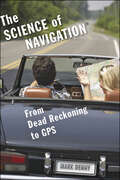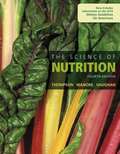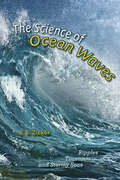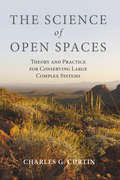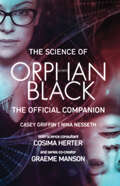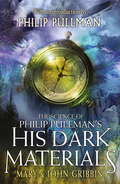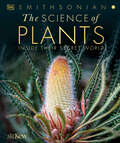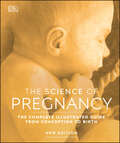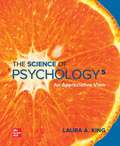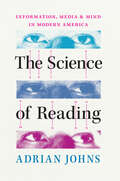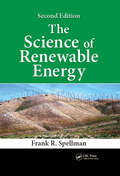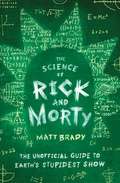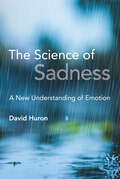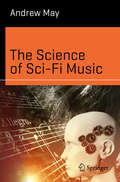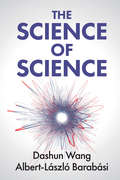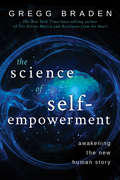- Table View
- List View
The Science of Navigation: From Dead Reckoning to GPS
by Mark DennyIn today’s world of online maps and travel directions delivered wirelessly to hand-held devices, getting from place to place requires little thought from most of us—which is a good thing, since accurate navigation can be tricky. Get your bearings with Mark Denny—an expert at explaining scientific concepts in non-technical language—in this all-encompassing look at the history and science of navigation.Denny’s tour kicks off with key facts about the earth and how its physical properties affect travel. He discusses cartography and early mapmakers, revealing fascinating tidbits such as how changes over time of the direction of true north, as well as of magnetic north, impacted navigation. Denny details the evolution of navigation from the days of coastal piloting to GPS and other modern-day technologies. He explains the scientific breakthroughs in accessible, amusing terms and provides an insightful look at their effects on societies, cultures, and human advancement. Throughout, Denny frames the long history of navigation with amazing tales of such people as Pytheas, an ancient Greek navigator, and Sir Francis Drake and of such discoveries as the magnetic compass and radio direction finding.Whether you have an interest in orienteering and geocaching or want to know more about the critical role navigation has played in human survival and progress since ancient people learned to use lodestones, The Science of Navigation is for you. With it you’ll finally understand the why of wayfinding.
The Science of Nutrition, Fourth Edition
by Janice L. Thompson Melinda M. Manore Linda A. VaughanThe Science of Nutrition is a college textbook.
The Science of Ocean Waves: Ripples, Tsunamis, and Stormy Seas
by J. B. ZirkerAn unparalleled introduction to the amazing world of ocean waves.Outstanding Academic Title, Choice"Powerful ocean waves fascinate the public, and they have made a lot of news lately." With that indisputable observation, scientist J. B. Zirker takes off on a whirlwind tour of the world of waves—from the "ordinary" waves that constantly churn the sea to the rogues or freaks that can rise up seemingly from nowhere to heights of 20 meters or more... and everything in between.Addressing questions most ocean visitors have had and offering new ones for our consideration, The Science of Ocean Waves explains in accessible language how waves are formed, how they move, how they become huge and destructive, and how they're being studied now for clues that will help us plan for the future.Devoting chapters to wind, tides, currents, breakers, tsunamis, forecasting, renewable energy, and El Niño—as well as discussing the gentler properties of ocean waves which inspire us and offer opportunities for relaxation and recreation—Zirker explores the physical factors that create waves.Drawing on some of the recent storms that have devastated entire regions—such as Hurricane Katrina, the tsunami launched by the 2004 Sumatran earthquake, and the great tsunami that crushed the shore of Japan in 2011—Zirker explains the forces that cause these monster waves and reveals the toll they take on human lives.Enhanced by dozens of illustrations and a comprehensive glossary, The Science of Ocean Waves will fascinate anyone curious about the science behind the headlines.Praise for J. B. Zirker"Scientists know their stuff but are rarely good storytellers, whereas good storytellers rarely possess the necessary sweeping command of a scientific discipline. Zirker is that rare animal who can both communicate the most demanding technical detail and make it accessible."—New Scientist
The Science of Open Spaces
by Charles CurtinFrom the days of the American Frontier, the term "open spaces" has evoked a vision of unspoiled landscapes stretching endlessly toward the horizon, of nature operating on its own terms without significant human interference. Ever since, government agencies, academia, and conservation organizations have promoted policies that treat large, complex systems with a one-size-fits-all mentality that fails to account for equally complex social dimensions of humans on the landscape. This is wrong, argues landscape ecologist and researcher Charles Curtin. We need a science-based approach that tells us how to think about our large landscapes and open spaces at temporally and spatially appropriate scales in a way that allows local landowners and other stakeholders a say in their futures. The Science of Open Spaces turns conventional conservation paradigms on their heads, proposing that in thinking about complex natural systems, whether the arid spaces of the southwestern United States or open seas shared by multiple nations, we must go back to "first principles"--those fundamental physical laws of the universe--and build innovative conservation from the ground up based on theory and backed up by practical experience. Curtin walks us through such foundational science concepts as thermodynamics, ecology, sociology, and resilience theory, applying them to real-world examples from years he has spent designing large-scale, place-based collaborative research programs in the United States and around the world. Compelling for not only theorists and students, but also practitioners, agency personnel, and lay readers, this book offers a thoughtful and radical departure from business-as-usual management of Earth's dwindling wide-open spaces.
The Science of Open Spaces: Theory and Practice for Conserving Large, Complex Systems
by Charles G. CurtinFrom the days of the American Frontier, the term "open spaces" has evoked a vision of unspoiled landscapes stretching endlessly toward the horizon, of nature operating on its own terms without significant human interference. Ever since, government agencies, academia, and conservation organizations have promoted policies that treat large, complex systems with a one-size-fits-all mentality that fails to account for equally complex social dimensions of humans on the landscape. This is wrong, argues landscape ecologist and researcher Charles Curtin. We need a science-based approach that tells us how to think about our large landscapes and open spaces at temporally and spatially appropriate scales in a way that allows local landowners and other stakeholders a say in their futures. The Science of Open Spaces turns conventional conservation paradigms on their heads, proposing that in thinking about complex natural systems, whether the arid spaces of the southwestern United States or open seas shared by multiple nations, we must go back to "first principles"--those fundamental physical laws of the universe--and build innovative conservation from the ground up based on theory and backed up by practical experience. Curtin walks us through such foundational science concepts as thermodynamics, ecology, sociology, and resilience theory, applying them to real-world examples from years he has spent designing large-scale, place-based collaborative research programs in the United States and around the world. Compelling for not only theorists and students, but also practitioners, agency personnel, and lay readers, this book offers a thoughtful and radical departure from business-as-usual management of Earth's dwindling wide-open spaces.
The Science of Orgasm
by Beverly Whipple Barry R. Komisaruk Carlos Beyer-FloresWinner, 2007 Bonnie and Vern L. Bullough Book Award, Foundation for the Scientific Study of SexualityThis fascinating and comprehensive book is the first to explore the complex biological process leading to orgasm. Here, sexuality researcher and nurse Beverly Whipple, coauthor of the international best-selling book The G Spot and Other Discoveries about Human Sexuality, joins neuroscientist Barry R. Komisaruk and endocrinologist Carlos Beyer-Flores to view orgasm through the lenses of behavioral neuroscience along with cognitive and physiological sciences. The authors explain how and why orgasms happen, why they fail to happen, and what brain and body events are put into play at the moment of orgasm. No topic is left unexplored, as the book describes the genital-brain connection, how the brain produces orgasms, how aging affects orgasm, and the effects of prescription medication, street drugs, hormones, disorders, and diseases. Covering every type of sexual peak experience in women and menfrom intense to phantom—this informative and entertaining work illuminates the hows, whats, and wherefores of orgasm.
The Science of Orgasm
by Beverly Whipple Barry R. Komisaruk Carlos Beyer-FloresThis award-winning book “offers a thorough compilation of what modern science, from biomechanics to neurochemistry, knows about the secrets of orgasm” (Publishers Weekly).The coauthor of the international best-selling book The G Spot and Other Discoveries about Human Sexuality, Beverly Whipple joins neuroscientist Barry R. Komisaruk and endocrinologist Carlos Beyer-Flores to view orgasm through the lenses of behavioral neuroscience along with cognitive and physiological sciences. Covering every type of sexual peak experience in women and men from intense to phantom, this fascinating and comprehensive work illuminates the hows, whats, and wherefores of orgasm.The authors explain how and why orgasms happen, why they fail to happen, and what brain and body events are put into play at the moment of orgasm. They also describes the genital-brain connection, how the brain produces orgasms, how aging affects orgasm, and the effects of prescription medication, street drugs, hormones, disorders, and diseases.Winner of the 2007 Bonnie and Vern L. Bullough Book Award, given by the Foundation for the Scientific Study of Sexuality
The Science of Orphan Black: The Official Companion
by Casey Griffin Nina Nesseth Cosima Herter Graeme MansonAn official guide to the crazy science of Orphan Black—from cloning to chimerism and much more. Delve deeper into the scientific terms and theories at the core of the Peabody-winning cult-favorite show. With exclusive insights from the show&’s co-creator Graeme Manson and science consultant Cosima Herter, The Science of Orphan Blacktakes you behind the closed doors of the Dyad Institute and inside Neolution, with color photos included. Authors Casey Griffin and Nina Nesseth decode the mysteries of Orphan Black—from the history of cloning, epigenetics, synthetic biology, chimerism, the real diseases on which the clone disease is based, and the transhumanist philosophies of Neolution, to what exactly happens when a projectile pencil is shot through a person&’s eye and into their brain.
The Science of Philip Pullman's His Dark Materials: With an Introduction by Philip Pullman
by John Gribbin Mary GribbinThe amazing true science behind the fiction of His Dark Materials, ideal for fans of the original trilogy and The Book of Dust, with an introduction by Philip Pullman.Award-winning science writers Mary and John Gribbin reveal how the world of Pullman's His Dark Materials trilogy (Northern Lights, The Subtle Knife and The Amber Spyglass) is rooted in astonishing scientific truth. Drawing on string theory and spacetime, quantum physics and chaos theory, they answer fascinating questions such as: could parallel worlds like Will's and Lyra's really exist? How does the subtle knife cut through anything? Could there be a bomb like the one made with Lyra's hair? And, of course, what are the Dark Materials?
The Science of Philip Pullman's His Dark Materials: With an Introduction by Philip Pullman
by John Gribbin Mary GribbinThe amazing true science behind the fiction of His Dark Materials, ideal for fans of the original trilogy and The Book of Dust, with an introduction by Philip Pullman.Award-winning science writers Mary and John Gribbin reveal how the world of Pullman's His Dark Materials trilogy (Northern Lights, The Subtle Knife and The Amber Spyglass) is rooted in astonishing scientific truth. Drawing on string theory and spacetime, quantum physics and chaos theory, they answer fascinating questions such as: could parallel worlds like Will's and Lyra's really exist? How does the subtle knife cut through anything? Could there be a bomb like the one made with Lyra's hair? And, of course, what are the Dark Materials?
The Science of Plants: Inside Their Secret World (DK Secret World Encyclopedias)
by DKCombining graceful design and beautiful imagery, this book provides an elegant introduction to the plant kingdom.Discover the extraordinary diversity of the plant world—and how plants work—with this photographic celebration of the trees, flowers, and foliage plants that share our planet. From tiny mosses and delicate ferns to vibrant blooms and stately palms, The Science of Plants invites you to explore the plant kingdom from the ground up, and from root to leaf tip. DK&’s elegant introduction to botany is packed with sumptuous photos and crystal-clear artworks that explain the mechanics of photosynthesis, why leaves change color, how cacti store water, and how seeds know when to grow. Filled with fascinating stories of how plants protect themselves from predators, and how flowers use color and scent to interact with—and manipulate—the creatures around them, The Science of Plants is a fresh and engaging introduction to the mysterious inner workings of the plant world.
The Science of Pregnancy: The Complete Illustrated Guide From Conception to Birth (DK Human Body Guides)
by DKFollow the amazing journey of the earliest stages of human life, with month-by-month development shown in unprecedented detail.The complex concepts and processes of emerging life are demystified with clear, jargon-free text, while exclusive 3-D images, extraordinary photographs, and detailed illustrations illuminate every aspect of human pregnancy. The largest section of the book examines the development of the baby in the womb and the parallel changes in the mother's body. Special 3-D art, illustrations, scans, and photographs show exactly how a baby changes and grows during pregnancy and how the female body adapts to carry it. A section on labor and birth explains these processes with step-by-step illustrations and easy-to-grasp text. The Science of Pregnancy also looks at the nature of human pregnancy, including how it evolved, and explores the anatomy and physiology of both the male and female reproductive systems. The mysteries of DNA and genetics are unraveled and explained in clear, illustrated detail, including patterns of inheritance and the interplay of genes and environment. Also provides straightforward, illustrated information on possible problems before, during, and after birth.
The Science of Psychology (2nd Edition)
by Bruce HinrichsWe begin our journey through the scientific discipline of psychology with an overview of the many vast dimensions of this fascinating field, and a look at the experimental methods that psychologists use. Here you will find a description of the many diverse subfields of psychology and of the scientific methods that provide the discipline of psychology with the tools for meeting its goals - to describe, explain, predict, and control the behavior and mental processes of animals, including, of course, humans.
The Science of Psychology: An Appreciative View
by Laura A. KingThis book communicates the nature and breadth of psychology -and its value as a science - with an emphasis on why things go right. With primary goals of teaching students to think like psychological scientists and focusing on the understanding of human strengths and capacities, health, and wellness, the book cultivates students’ appreciation for how extensively psychology applies to their lives.
The Science of Reading: Information, Media, and Mind in Modern America
by Adrian JohnsFor the first time, the story of how and why we have plumbed the mysteries of reading, and why it matters today. Reading is perhaps the essential practice of modern civilization. For centuries, it has been seen as key to both personal fulfillment and social progress, and millions today depend on it to participate fully in our society. Yet, at its heart, reading is a surprisingly elusive practice. This book tells for the first time the story of how American scientists and others have sought to understand reading, and, by understanding it, to improve how people do it. Starting around 1900, researchers—convinced of the urgent need to comprehend a practice central to industrial democracy—began to devise instruments and experiments to investigate what happened to people when they read. They traced how a good reader’s eyes moved across a page of printed characters, and they asked how their mind apprehended meanings as they did so. In schools across the country, millions of Americans learned to read through the application of this science of reading. At the same time, workers fanned out across the land to extend the science of reading into the social realm, mapping the very geography of information for the first time. Their pioneering efforts revealed that the nation’s most pressing problems were rooted in drastic informational inequities, between North and South, city and country, and white and Black—and they suggested ways to tackle those problems. Today, much of how we experience our information society reflects the influence of these enterprises. This book explains both how the science of reading shaped our age and why, with so-called reading wars still plaguing schools across the nation, it remains bitterly contested.
The Science of Reading: Information, Media, and Mind in Modern America
by Adrian JohnsFor the first time, the story of how and why we have plumbed the mysteries of reading, and why it matters today. Reading is perhaps the essential practice of modern civilization. For centuries, it has been seen as key to both personal fulfillment and social progress, and millions today depend on it to participate fully in our society. Yet, at its heart, reading is a surprisingly elusive practice. This book tells for the first time the story of how American scientists and others have sought to understand reading, and, by understanding it, to improve how people do it. Starting around 1900, researchers—convinced of the urgent need to comprehend a practice central to industrial democracy—began to devise instruments and experiments to investigate what happened to people when they read. They traced how a good reader’s eyes moved across a page of printed characters, and they asked how their mind apprehended meanings as they did so. In schools across the country, millions of Americans learned to read through the application of this science of reading. At the same time, workers fanned out across the land to extend the science of reading into the social realm, mapping the very geography of information for the first time. Their pioneering efforts revealed that the nation’s most pressing problems were rooted in drastic informational inequities, between North and South, city and country, and white and Black—and they suggested ways to tackle those problems. Today, much of how we experience our information society reflects the influence of these enterprises. This book explains both how the science of reading shaped our age and why, with so-called reading wars still plaguing schools across the nation, it remains bitterly contested.
The Science of Renewable Energy
by Frank R. SpellmanLatest Edition Explores Fresh, New Alternatives to Fossil FuelsThe Science of Renewable Energy, Second Edition takes a look at ways to produce sustainable and reliable energy sources and presents practical examples along with scientific methods, models, observations, and tools. Developed by esteemed author Frank R. Spellman, this book includes inpu
The Science of Rick and Morty: The Unofficial Guide to Earth's Stupidest Show
by Matt BradyExplore the real science behind the Cartoon Network phenomenon Rick and Morty—one of television’s most irreverent, whip-smart, and darkly hilarious shows—and discover how close we are to Rick’s many experiments becoming a reality. Adult Swim’s Rick and Morty is one of the smartest (and most insane) shows on television. Genius alcoholic Rick Sanchez and his hapless grandson Morty have explored everything from particle physics to human augmentation and much more in their intergalactic adventures through the multiverse. With biting humor and plenty of nihilism, Rick and Morty employs cutting-edge scientific theories in every episode. But, outside of Rick’s garage laboratory, what are these theories truly about and what can they teach us about ourselves? Blending biology, chemistry, and physics basics with accessible—and witty—prose, The Science of Rick and Morty equips you with the scientific foundation to thoroughly understand Rick’s experiments from the show, such as how we can use dark matter and energy, just what is intelligence hacking, and whether or not you can really control a cockroach’s nervous system with your tongue. Perfect for longtime and new fans of the show, this is the ultimate segue into discovering more about our complicated and fascinating universe.
The Science of Roman History: Biology, Climate, and the Future of the Past
by Walter ScheidelHow the latest cutting-edge science offers a fuller picture of life in Rome and antiquity. <p><p>This groundbreaking book provides the first comprehensive look at how the latest advances in the sciences are transforming our understanding of ancient Roman history. Walter Scheidel brings together leading historians, anthropologists, and geneticists at the cutting edge of their fields, who explore novel types of evidence that enable us to reconstruct the realities of life in the Roman world. <p><p>Contributors discuss climate change and its impact on Roman history, and then cover botanical and animal remains, which cast new light on agricultural and dietary practices. They exploit the rich record of human skeletal material—both bones and teeth—which forms a bio-archive that has preserved vital information about health, nutritional status, diet, disease, working conditions, and migration. Complementing this discussion is an in-depth analysis of trends in human body height, a marker of general well-being. <p><p>This book also assesses the contribution of genetics to our understanding of the past, demonstrating how ancient DNA is used to track infectious diseases, migration, and the spread of livestock and crops, while the DNA of modern populations helps us reconstruct ancient migrations, especially colonization. <p><p>Opening a path toward a genuine biohistory of Rome and the wider ancient world, The Science of RomanHistory offers an accessible introduction to the scientific methods being used in this exciting new area of research, as well as an up-to-date survey of recent findings and a tantalizing glimpse of what the future holds.
The Science of Sadness: A New Understanding of Emotion
by David HuronAn accessible, scientific account of grief, melancholy, and nostalgia in human life and their broader lessons for understanding emotions in general.The Science of Sadness proposes an original scientific account of grief, melancholy, and nostalgia, advocating a unique ethological approach to these familiar, woeful emotions. One of the leading scholars in the psychology of music and music cognition, David Huron draws on hundreds of studies from physiology, medicine, neuroscience, psychology, anthropology, and the arts to resolve long-standing problems that have stymied modern emotion research. A careful examination of sadness-related behaviors reveals their biological and social functions, which Huron uses to formulate a new theory about how emotions in general are displayed and interpreted.We&’ve all shed tears of joy, tears of grief, tears of pain. While different emotions often share the same weepy display, Huron identifies the single function that unites them. He suggests how weeping emerged over the course of human evolution, explores the contrasting cultural manifestations of sadness, and chronicles humanity&’s changing interpretations of sadness over time. Huron also explains the various ways cultures recruit and reshape involuntary emotional displays for different social purposes, and he offers a compelling narrative of what makes tragic arts so appealing. Though sadness is typically regarded as the very antithesis of happiness, The Science of Sadness draws attention to the important roles that grief, melancholy, and nostalgia play in human well-being.
The Science of Sci-Fi Music (Science and Fiction)
by Andrew MayThe 20th century saw radical changes in the way serious music is composed and produced, including the advent of electronic instruments and novel compositional methods such as serialism and stochastic music. Unlike previous artistic revolutions, this one took its cues from the world of science. Creating electronic sounds, in the early days, required a well-equipped laboratory and an understanding of acoustic theory. Composition became increasingly “algorithmic”, with many composers embracing the mathematics of set theory. The result was some of the most intellectually challenging music ever written – yet also some of the best known, thanks to its rapid assimilation into sci-fi movies and TV shows, from the electronic scores of Forbidden Planet and Dr Who to the other-worldly sounds of 2001: A Space Odyssey.This book takes a close look at the science behind "science fiction" music, as well as exploring the way sci-fi imagery found its way into the work of musicians like Sun Ra and David Bowie, and how music influenced the science fiction writings of Philip K. Dick and others.
The Science of Science
by Albert-László Barabási Dashun WangThis is the first comprehensive overview of the exciting field of the 'science of science'. Those concerned with maximizing their career impact and productivity, with their scientific creativity, with effective collaboration and with the metrics of assessment will better understand the fundamental workings of science. Big data analysis and quantitative tools help identify success and failure within the discipline. Areas in the 'science of science' that are ripe for further research are explored, and the implications this could have for future technological and innovative work are examined. With anecdotes and detailed, easy-to-follow explanations of the research, this book is accessible to all scientists, policy makers, and administrators with an interest in the wider scientific enterprise.
The Science of Science Fiction: The Influence of Film and Fiction on the Science and Culture of Our Times
by Mark BrakeWe are the first generation to live in a science fiction world.Media headlines declare this the age of automation. The TV talks about the coming revolution of the robot, tweets tell tales of jets that will ferry travelers to the edge of space, and social media reports that the first human to live for a thousand years has already been born. The science we do, the movies we watch, and the culture we consume is the stuff of fiction that became fact, the future imagined in our past—the future we now inhabit.The Science of Science Fiction is the story of how science fiction shaped our world. No longer a subculture, science fiction has moved into the mainstream with the advent of the information age it helped realize. Explore how science fiction has driven science, with topics that include:Guardians of the Galaxy: Is Space Full of Extraterrestrials?Jacking In: Will the Future Be Like Ready Player One?Mad Max: Is Society Running down into Chaos?The Internet: Will Humans Tire of Mere Reality?Blade Runner 2049: When Will We Engineer Human Lookalikes?And many more! This book will open your eyes to the way science fiction helped us dream of things to come, forced us to explore the nature and limits of our own reality, and aided us in building the future we now inhabit.
The Science of Science Policy
by Kaye Husbands Fealing Julia I. Lane John H. Marburger Stephanie S. ShippContributors from political science, economics, and various specific natural and social sciences, analyze the formation of public science policy with a theoretical and methodological rigor that is common to most areas of policy but not, they say, of science policy. Covering in turn theory, measurement and data issues, and practical matters, they discuss such topics as sociology and the science of science policy, a situated cognition view of innovation with implications for innovative policy, legacy and new databases for linking innovation to impact, a vision of data and analytics for the science of science policy, the problems of political design in federal innovation organization, and institutional ecology and the social outcomes of scientific research. Annotation ©2011 Book News, Inc. , Portland, OR (booknews. com)
The Science of Self-Empowerment: Awakening the New Human Story
by Gregg BradenNow in paperback: At the cutting edge of science and spirituality, New York Times best-selling author Gregg Braden explains that evolution is not the whole story of humanity--and offers a new understanding of our origins that can help us tap the extraordinary abilities we already have.What would it mean to discover we're designed to live extraordinary lives of self-healing, longevity, and deep intuition? Is it possible that the advanced awareness achieved by monks, nuns, and mystics--considered rare in the past--is actually meant to be a normal part of our daily lives? In this revelatory book, now available for the first time in paperback, five-time New York Times best-selling author and 2018 Templeton Award nominee Gregg Braden explains that we no longer need to ask these questions as "What if?" Recent discoveries ranging from human evolution and genetics to the new science of neuro-cardiology (the bridge between the brain and the heart) have overturned 150 years of thinking when it comes to the way we think of ourselves, our origin, and our capabilities. In this reader-friendly journey of discovery, Braden begins with the fact that we exist as we do, even more empowered, and more connected with ourselves and the world than scientists have believed in the past. It's this undisputable fact that leads to even deeper mysteries. "How do we awaken the extraordinary abilities that come from such an awesome connection?" "What role does our ancient and mysterious heritage play in our lives today?" Join Gregg as he crosses the traditional boundaries of science and spirituality to answer precisely these questions. In doing so he reveals a) specific tools, techniques, and practices to awaken our deep intuition on-demand, for self healing and longevity; and 2) concrete solutions to the social issues that are destroying our families and dividing us as people, including the bullying of young people, hate crimes, the growing epidemic of suicide, religious extremism, and more.When new discoveries prove that the existing human story is no longer based in fact, it's time to change the story. This simple truth is at the heart of the book you're about to read.
